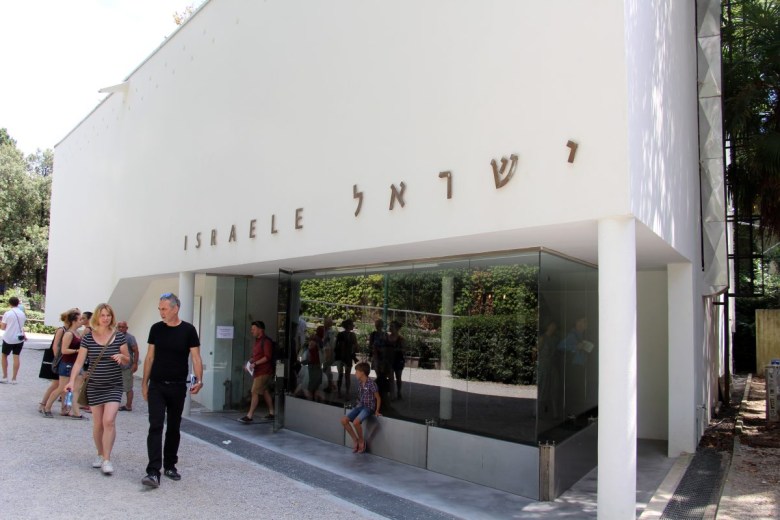Ahead of the 60th Venice Biennale’s public opening next week, the artist and curators of Israel’s national pavilion have shuttered the exhibition space as of Tuesday, April 16, with the promise to open “when a ceasefire and hostage release agreement is reached.” Israel’s controversial participation in this year’s Biennale was met with fervent opposition, with one petition from the Art Not Genocide Alliance (ANGA) calling for the pavilion’s exclusion drawing almost 24,000 signatories.
“The decision by the artist and curators is not to cancel themselves nor the exhibition; rather, they choose to take a stance in solidarity with the families of the hostages and the large community in Israel who is calling for change,” wrote Ruth Patir, the artist selected to represent Israel at the Biennale, in a statement on her website.
Titled (M)otherland (2024) and curated by Tamar Margalit of the Center for Contemporary Art Tel Aviv-Yafo and Mira Lapidot of the Tel Aviv Museum of Art, the pavilion includes several new time-based works by Patir along with excavated statuettes of fertility goddesses dated between the 8th and 6th century BCE. The presentation expands on Patir’s experience with being pressured to freeze her eggs to retain a chance at motherhood after testing positive for the BRCA2 gene mutation, which yields a high risk for breast and ovarian cancer.

Neither Patir nor the curators immediately responded to Hyperallergic’s request for comment. The artist told the New York Times that the Israeli government, which paid for about half of the pavilion costs, hadn’t been informed of the decision to close the exhibition. She added that she hopes that an agreement comes by November and that she can share her work with visitors. (The Biennale opens to the public on April 2o and closes on November 24.)
Patir’s first-floor animation is currently still visible from outside the pavilion through the structure’s glass doors.

ANGA, the anonymous group of artists and culture workers who penned the February petition against Israel’s participation in the Biennale, stating that “platforming art representing a state engaged in ongoing atrocities against Palestinians in Gaza is unacceptable,” said that the gesture from Patir and the curators didn’t go far enough.
“ANGA does not applaud empty and opportunistic gestures timed for maximum press coverage, and leaving video works on view to the public, while Palestinians are killed by Israel every hour and millions face imminent famine,” reads a section of the group’s Instagram statement, reiterating its demand that the pavilion close entirely and underscoring that the artist and curators halted the exhibition only after pressure from thousands of petition signatories.
Reached by Hyperallergic to comment on the exhibition’s suspension, Omar Barghouti, co-founder of the Boycott, Divest, Sanctions (BDS) movement for Palestinian rights, said the perpetrators of the “world’s first live-streamed genocide” should be shunned worldwide. He noted that the Palestinian Campaign for the Academic and Cultural Boycott of Israel (PACBI), an effort that is part of the BDS movement, is calling for “escalating nonviolent pressure, including disruption, to shut down Israel’s Genocide Pavilion.”
“PACBI agrees with ANGA that artists and curators who have accepted to represent Israel during its ongoing massacres and are now trying to distance themselves from its far-right government are reacting to the unprecedented pressure from conscientious artists,” Barghouti said. “The hypocritical and complicit Venice Biennale, which had in the past excluded apartheid South Africa and more recently Russia, is today shamefully enabling apartheid Israel to artwash its genocide.”

Faisal Saleh, founder and director of the Palestine Museum US in Connecticut, said he would be very interested to know whether the ceasefire the pavilion team is calling for is temporary or permanent, and if the suspension “includes providing food and aid to the people of Gaza.”
Saleh then turned the mirror back on the other countries participating in the Biennale this year and the artists representing them, opining that the larger issue is the “pavilions of the nations that are enabling Israel.”
“The United States, United Kingdom, Germany, France — they’re enabling the genocide and destruction in Gaza,” Saleh said. “So the artists who are participating in these countries’ pavilions must understand that they are not representing themselves. What are they going to tell their children years from now that they were doing during the genocide of Gaza? Are they going to tell them ‘we were making the countries that supplied the bombs look good’? That’s what they need to ask themselves.”
Saleh mentioned that museum’s collateral exhibition proposal for Palestinian art from within and outside of the terror in Gaza had been rejected by the Biennale, but is still taking place externally at the European Culture Center’s Palazzo Mora starting April 20. The exhibition, Foreigners in their Homeland: Occupation, Apartheid, Genocide, includes work by artists Maisara Baroud and Mohammed Alhaj, who are still sheltering in Gaza, and a new painting by Samia Halaby, whose first US retrospective at the University of Indiana at Bloomington was abruptly canceled ahead of its opening earlier this year.

